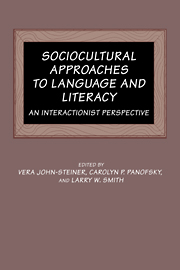Book contents
- Frontmatter
- Contents
- List of contributors
- 1 Introduction
- Part 1 Context
- Part II Mediational processes
- 5 Nonverbal factors in the interpsychic to intrapsychic internalization of objects
- 6 An ecological approach to the emergence of the lexicon: Socializing attention
- 7 Learning how to explain: The effects of mother's language on the child
- 8 Developing the representational functions of language: The role of parent–child book-reading activity
- 9 The implications of Vygotskian theory for the development of home-school programs: A focus on storybook reading
- 10 Vygotsky in the classroom: An interactionist literacy framework in mathematics
- Part III Functional systems
- Author index
- Subject index
7 - Learning how to explain: The effects of mother's language on the child
Published online by Cambridge University Press: 05 November 2011
- Frontmatter
- Contents
- List of contributors
- 1 Introduction
- Part 1 Context
- Part II Mediational processes
- 5 Nonverbal factors in the interpsychic to intrapsychic internalization of objects
- 6 An ecological approach to the emergence of the lexicon: Socializing attention
- 7 Learning how to explain: The effects of mother's language on the child
- 8 Developing the representational functions of language: The role of parent–child book-reading activity
- 9 The implications of Vygotskian theory for the development of home-school programs: A focus on storybook reading
- 10 Vygotsky in the classroom: An interactionist literacy framework in mathematics
- Part III Functional systems
- Author index
- Subject index
Summary
Within the Vygotskian framework, explanations are a basic device for development and socialization. This chapter describes a study of mother–child interaction designed to analyze the contents and strategies of the mother's explanations, and their effects on the child. The aim was to test whether children incorporate maternal explanations and to explain how they do so.
However, before any study of the emergence of the explaining capacity in children can start, a definition of the object of inquiry is required.
An implicit assumption of our culture defines explanations as “the search for causes.” In the psychological literature, Piaget is the most representative author of this approach. According to his view, the origin of the explaining capacity is linked to children's increasing ability to formulate correct representations of causal sequences, and make appropriate use of the connectives expressing this relation between two or more events. He discussed the issue of children's explanations in four books: The Language and Thought of the Child (first French edition 1923), Judgement and Reasoning in the Child (first French edition 1924), The Child's Conception of the World (first French edition 1926) and The Child's Conception of Physical Causality (first French edition 1927). At the time, he wanted to develop a treatise on children's logic aimed at describing the features of their reasoning. Egocentrism was a central concept for the author. He claimed that the lack of distinction between “subject” and “object” affected reasoning, understanding of reality, and use of language in children.
- Type
- Chapter
- Information
- Sociocultural Approaches to Language and LiteracyAn Interactionist Perspective, pp. 191 - 222Publisher: Cambridge University PressPrint publication year: 1994

